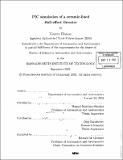| dc.contributor.advisor | Manuel Martínez-Sánchez. | en_US |
| dc.contributor.author | Blateau, Vincent, 1979- | en_US |
| dc.contributor.other | Massachusetts Institute of Technology. Dept. of Aeronautics and Astronautics. | en_US |
| dc.date.accessioned | 2006-03-24T16:22:18Z | |
| dc.date.available | 2006-03-24T16:22:18Z | |
| dc.date.copyright | 2002 | en_US |
| dc.date.issued | 2002 | en_US |
| dc.identifier.uri | http://hdl.handle.net/1721.1/29753 | |
| dc.description | Thesis (S.M.)--Massachusetts Institute of Technology, Dept. of Aeronautics and Astronautics, 2002. | en_US |
| dc.description | Includes bibliographical references (leaves 99-101). | en_US |
| dc.description.abstract | A full Particle-In-Cell code, written by James Szabo [23], was used to model a 50W TAL and 3kW SPT thruster. This code treats single and double ions, neutrals and electrons as particles, moved forward by a leapfrog algorithm at each timestep, matching the lowest of the plasma and the cyclotron times. At the end of each timestep, a successive-over-relaxation algorithm solves the Gauss' formulation of the Poisson equation. Collisions include electron-neutral single and double ionization, and elastic scattering, electron-ion double ionization, ion-neutral elastic scattering and chargeexchange. A few tricks are used to decrease the computation time: superparticles, an artificial permittivity factor and lighter-than-physical ions. We modified this code to track the different components governing the thruster efficiency, and to map average internal data in the thruster. We used these tools to track changes with higher-than- nominal voltage (600, 900 and 1200V) for the 50W, 300V mini-TAL, optimizing efficiency vs. magnetic fields at each voltage. We further modified the code to model a 3kW SPT thruster. These modifications include ceramic wall secondary electron emission, a new boundary condition model for the Poisson solver at ceramic walls, an improved sheath model, and a new anomalous diffusion algorithm. Converged results with low anomalous diffusion diffusion were obtained, along with intermediary results with higher diffusion. | en_US |
| dc.description.statementofresponsibility | by Vincent Blateau. | en_US |
| dc.format.extent | 101 leaves | en_US |
| dc.format.extent | 3293381 bytes | |
| dc.format.extent | 3293187 bytes | |
| dc.format.mimetype | application/pdf | |
| dc.format.mimetype | application/pdf | |
| dc.language.iso | eng | en_US |
| dc.publisher | Massachusetts Institute of Technology | en_US |
| dc.rights | M.I.T. theses are protected by copyright. They may be viewed from this source for any purpose, but reproduction or distribution in any format is prohibited without written permission. See provided URL for inquiries about permission. | en_US |
| dc.rights.uri | http://dspace.mit.edu/handle/1721.1/7582 | |
| dc.subject | Aeronautics and Astronautics. | en_US |
| dc.title | PIC simulation of a ceramic-lined Hall-effect thruster | en_US |
| dc.title.alternative | Particle-In-Cell simulation of a ceramic-lined Hall-effect thruster | en_US |
| dc.type | Thesis | en_US |
| dc.description.degree | S.M. | en_US |
| dc.contributor.department | Massachusetts Institute of Technology. Department of Aeronautics and Astronautics | |
| dc.identifier.oclc | 54448183 | en_US |
